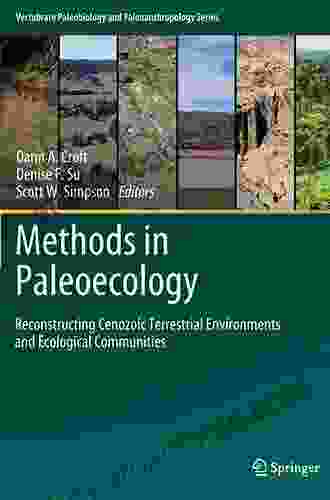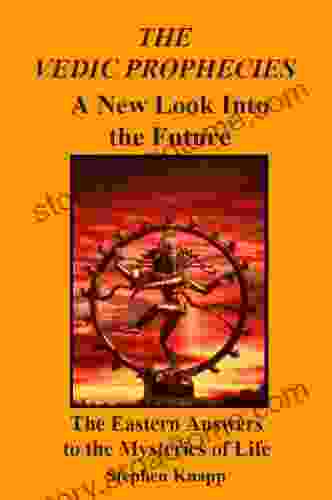Unveiling the Past: Reconstructing Cenozoic Terrestrial Environments and Ecological Communities

5 out of 5
| Language | : | English |
| File size | : | 23754 KB |
| Text-to-Speech | : | Enabled |
| Screen Reader | : | Supported |
| Enhanced typesetting | : | Enabled |
| Print length | : | 1190 pages |
The Cenozoic Era, spanning from 66 million years ago to the present, has witnessed a remarkable transformation of Earth's terrestrial landscapes and the evolution of a vast array of ecological communities. Reconstructing these ancient environments and unraveling the complex relationships between species and their surroundings is a captivating endeavor that provides invaluable insights into the history of our planet and the processes that have shaped its biodiversity.
Exploring Diverse Terrestrial Environments
Through meticulous analysis of fossil records and geological data, paleoecologists have pieced together a vibrant tapestry of Cenozoic terrestrial environments. From the lush rainforests that once covered vast expanses of land to the arid deserts that stretched across continents, each environment harbored a unique assemblage of plants and animals.
Lush Rainforests
During the early Cenozoic, the Earth's surface was dominated by vast tropical rainforests, teeming with life. Towering trees formed dense canopies, casting shadows upon a carpet of diverse vegetation. The air buzzed with the sounds of insects and birds, while mammals took refuge in the understory or swung through the branches. These rainforests served as a cradle of evolution, giving rise to numerous species that would later disperse to other parts of the globe.
Arid Deserts
In contrast to the lush rainforests, arid deserts emerged in regions where rainfall was scarce. These desolate landscapes were characterized by sparse vegetation and extreme temperature fluctuations. Despite their harsh conditions, deserts harbored a remarkable array of specialized organisms, including drought-tolerant plants, burrowing mammals, and reptiles that could endure the extreme heat.
Temperate Forests
As the climate cooled during the late Cenozoic, temperate forests began to replace the tropical rainforests. These forests exhibited a mix of deciduous and evergreen trees, providing a mosaic of habitats for a variety of animals. Seasonal changes brought about distinct patterns of life, as plants and animals adapted to the changing availability of resources.
Unraveling Ecological Communities
Within these diverse terrestrial environments, intricate ecological communities flourished. Plants, animals, and microorganisms interacted in complex ways, forming food webs and nutrient cycles that sustained the delicate balance of nature.
Trophic Relationships
Fossil evidence reveals the intricate web of trophic relationships that existed within Cenozoic communities. Herbivores grazed on a variety of plants, ranging from towering trees to delicate grasses. Carnivores preyed upon herbivores, while scavengers and decomposers played crucial roles in recycling nutrients back into the ecosystem.
Symbiotic Associations
Symbiotic relationships were also prevalent during the Cenozoic. Plants formed mutually beneficial partnerships with fungi, allowing them to access essential nutrients from the soil. Insects and flowers engaged in complex pollination relationships, ensuring the survival and reproduction of both species.
Biodiversity Patterns
The diversity and composition of ecological communities varied greatly over time and across different regions. Climate change, geological events, and the arrival of new species played significant roles in shaping these patterns. The fossil record reveals periods of high biodiversity, such as the Eocene "Green River" fauna, as well as times of mass extinctions, such as the end-Cretaceous event.
Impacts of Climate Change and Human Activity
The Cenozoic Era has been marked by significant climate fluctuations, which have profoundly influenced terrestrial environments and ecological communities. Periods of warming and cooling have led to the expansion and contraction of forests, the development of ice sheets, and the emergence of new species.
Human activity has also had a major impact on Cenozoic terrestrial environments. Deforestation, land use changes, and the of invasive species have altered habitats and disrupted ecological communities. Understanding the long-term consequences of these changes is crucial for informing conservation efforts and mitigating future impacts.
Significance for Conservation and Sustainability
The study of Cenozoic terrestrial environments and ecological communities offers valuable lessons for conservation and sustainability in the present day. By understanding how past ecosystems have responded to environmental changes, we can better predict the potential impacts of current and future anthropogenic activities.
Reconstructing past environments can also guide conservation efforts by identifying areas of high biodiversity and prioritizing habitats for protection. By learning from the past, we can strive to create a more sustainable future for both humans and the natural world.
Reconstructing Cenozoic terrestrial environments and ecological communities is a fascinating journey into the history of life on Earth. By unraveling the secrets of the past, we gain a deeper understanding of the complex interactions between species and their surroundings, the impacts of climate change, and the role of human activity in shaping the planet's ecosystems. This knowledge empowers us to make informed decisions for the conservation and sustainability of our planet for generations to come.
5 out of 5
| Language | : | English |
| File size | : | 23754 KB |
| Text-to-Speech | : | Enabled |
| Screen Reader | : | Supported |
| Enhanced typesetting | : | Enabled |
| Print length | : | 1190 pages |
Do you want to contribute by writing guest posts on this blog?
Please contact us and send us a resume of previous articles that you have written.
 Book
Book Novel
Novel Page
Page Chapter
Chapter Text
Text Story
Story Genre
Genre Reader
Reader Library
Library Paperback
Paperback E-book
E-book Magazine
Magazine Newspaper
Newspaper Paragraph
Paragraph Sentence
Sentence Bookmark
Bookmark Shelf
Shelf Glossary
Glossary Bibliography
Bibliography Foreword
Foreword Preface
Preface Synopsis
Synopsis Annotation
Annotation Footnote
Footnote Manuscript
Manuscript Scroll
Scroll Codex
Codex Tome
Tome Bestseller
Bestseller Classics
Classics Library card
Library card Narrative
Narrative Biography
Biography Autobiography
Autobiography Memoir
Memoir Reference
Reference Encyclopedia
Encyclopedia Linda Pendleton
Linda Pendleton Mirko Trenkner
Mirko Trenkner Mark Biddiss
Mark Biddiss Lynn Austin
Lynn Austin Louise S G
Louise S G Lisa Bentley
Lisa Bentley Martin Farrell
Martin Farrell Thomas Bulfinch
Thomas Bulfinch Lutz D Schmadel
Lutz D Schmadel Megan Kreiner
Megan Kreiner Lynne Edwards
Lynne Edwards Lee Holmes
Lee Holmes Paul Michaels
Paul Michaels Linda Reiss Volin
Linda Reiss Volin Life Magazine
Life Magazine Lila Corwin Berman
Lila Corwin Berman Maggie Reed
Maggie Reed Mahtab Rohan
Mahtab Rohan Stephen A Paget
Stephen A Paget Student Edition Kindle Edition
Student Edition Kindle Edition
Light bulbAdvertise smarter! Our strategic ad space ensures maximum exposure. Reserve your spot today!

 Joseph FosterWriting Well in the 21st Century: Crafting Compelling Content in the Digital...
Joseph FosterWriting Well in the 21st Century: Crafting Compelling Content in the Digital... Jett PowellFollow ·6.4k
Jett PowellFollow ·6.4k Gabriel MistralFollow ·5.3k
Gabriel MistralFollow ·5.3k Mark TwainFollow ·14.2k
Mark TwainFollow ·14.2k Will WardFollow ·2k
Will WardFollow ·2k Percy Bysshe ShelleyFollow ·5.5k
Percy Bysshe ShelleyFollow ·5.5k Curtis StewartFollow ·6.3k
Curtis StewartFollow ·6.3k Edward ReedFollow ·6.2k
Edward ReedFollow ·6.2k Edwin CoxFollow ·19.8k
Edwin CoxFollow ·19.8k

 E.M. Forster
E.M. ForsterThe Real Blueprint to Short-Term Rental Success
Are you ready to create a...

 Mark Mitchell
Mark MitchellMidas Touch: The Astrology Of Wealth
Are you ready to tap into the cosmic forces...

 Grant Hayes
Grant HayesPrecarious Creativity: Unpacking the Global Media and...
In the ever-evolving landscape of the...

 Cameron Reed
Cameron ReedGuru Govind Singh: A Life of Courage and Inspiration for...
Guru Govind Singh, the tenth Sikh guru,...

 Yukio Mishima
Yukio MishimaCastles & Shapes: The Enchanting World of Ris...
In the realm of...

 Jerome Blair
Jerome BlairGolden Keys To Jyotisha Volume Ten: The Ultimate Guide to...
Embark on an...
5 out of 5
| Language | : | English |
| File size | : | 23754 KB |
| Text-to-Speech | : | Enabled |
| Screen Reader | : | Supported |
| Enhanced typesetting | : | Enabled |
| Print length | : | 1190 pages |










